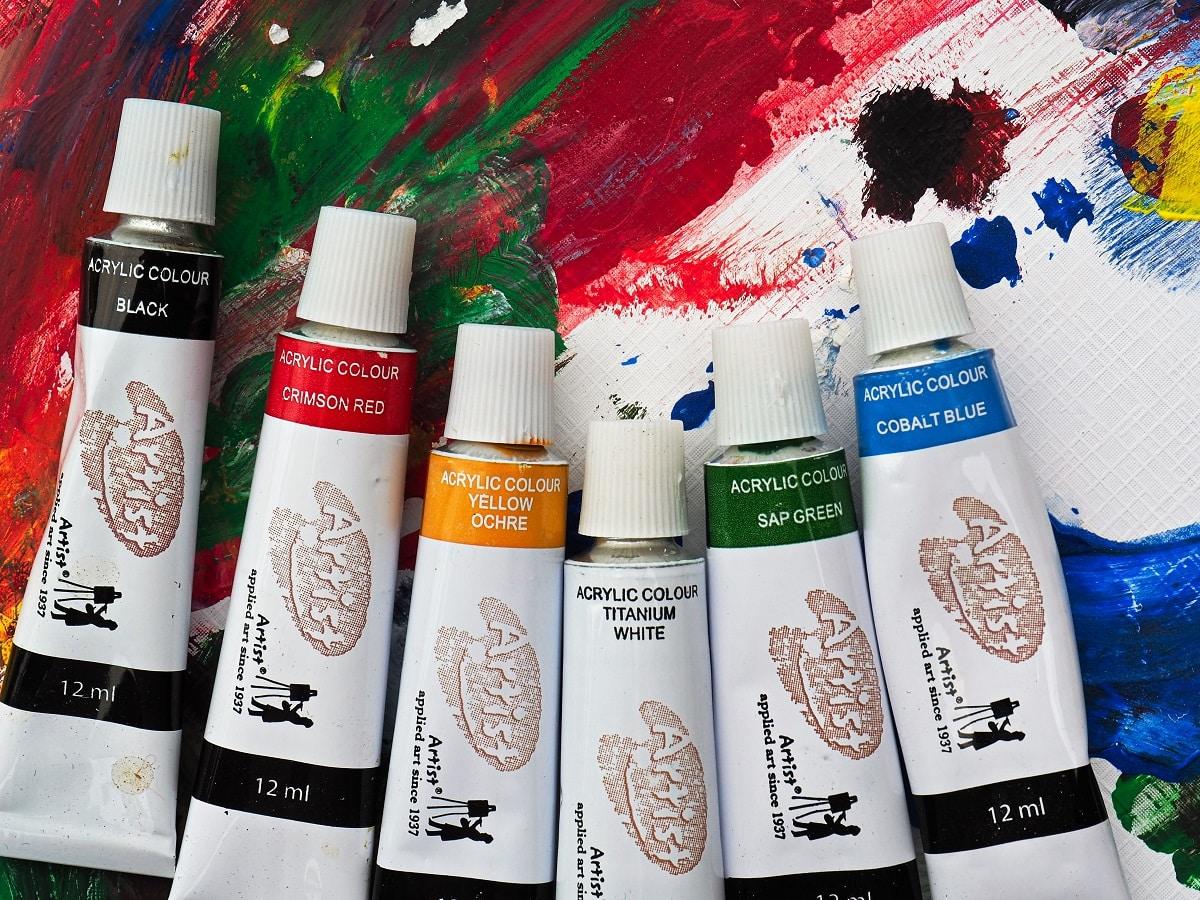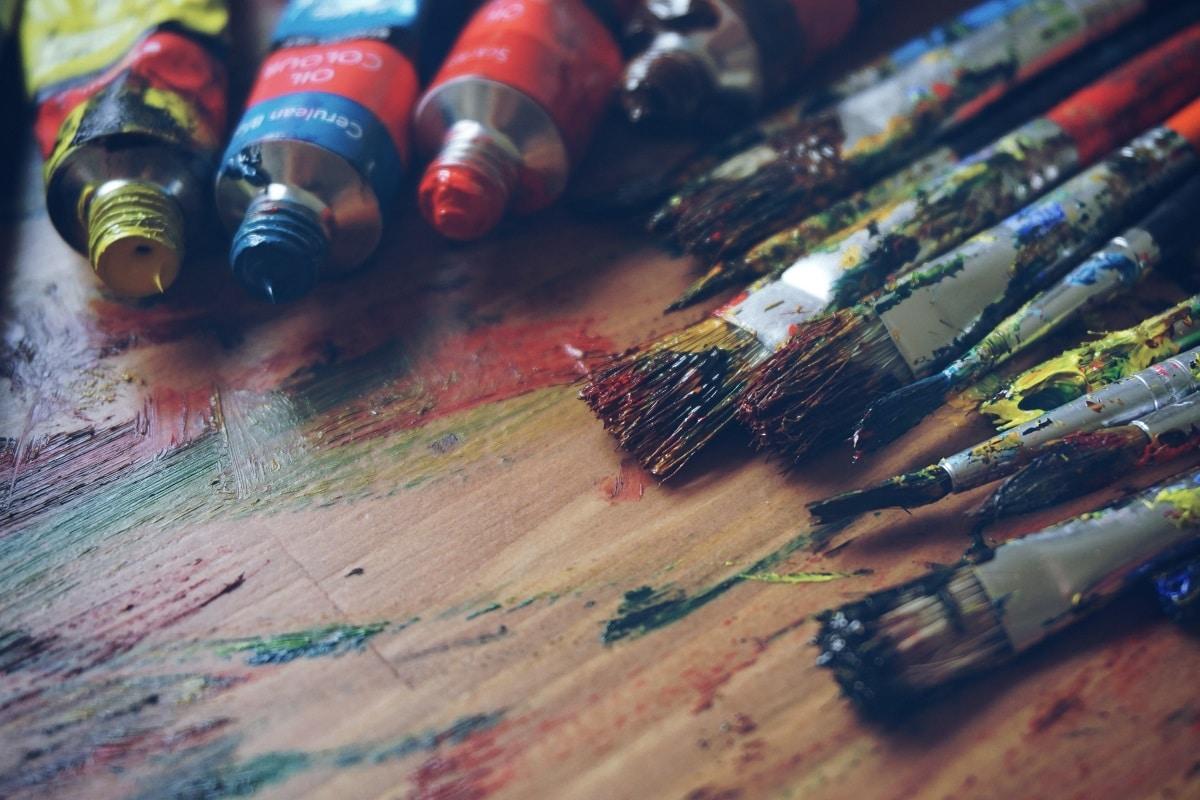Painting with acrylic mediums is one of the most versatile ways to create masterpieces because they work quite well on any surface, including canvas. But you need to know about the best acrylic paint brands, how to use them, best brushes for acrylic painting, and much more.
That’s why before you start your artistic journey with acrylic paints, it’s always best to do some solid research. If you’re wondering whether acrylic paint expires, the short answer is no; it can’t technically expire because it’s a synthetic-based material. However, it tends to dry out, freeze, or develop mold over time due to environmental factors.
Today, we’ll discuss what factors can make acrylic paints go bad and how you can revive them.
How Long Can Acrylic Paints Last After Opening?

The most common question that beginners have about acrylics is: how long do acrylic paints last? In theory, acrylic paints can last for 5-10 years once they are opened, but their shelf life depends on their quality and how well they are stored. For instance, when stored correctly, artist-quality acrylics usually have a longer shelf life than ordinary acrylic paints.
Several environmental factors, such as excessive heat or extreme cold, also come into play and affect the longevity of acrylic paints. Once you open the paints, they are exposed to humidity and bacterial contamination if they are not stored properly.
In contrast, unopened acrylic paints can last for decades and are mostly usable even after 10 years. But, proper storage is equally important for both opened and unopened acrylic paints; otherwise, environmental factors can ruin the chemical composition of the paints.
Why Does Acrylic Paint Expire?
1. Excessive Heat
Acrylic paint is a synthetic material containing heat-sensitive chemicals and color pigments susceptible to high temperatures. These paints can dry up pretty quickly, which is both their best and worst quality.
If the acrylic paint is exposed to high heat, it will lose water and dry up within minutes, becoming hard and brittle. While controlled heat exposure can reduce the drying time of your acrylic painting, excessive heat can ruin it altogether.
The best way to prevent your paint from drying up due to extreme heat is to use some wetting agents and store them in a temperature-controlled area.
2. Extreme Cold
Acrylic paint is made by chemical emulsion, a process of mixing two or more substances that usually do not mix. When it is exposed to chilling temperatures, the chemicals separate and cause the paint to break off.
The separation occurs because the extreme cold affects the chemical composition of the paint, leading it to disintegrate. If acrylic paints become excessively cold, they freeze and turn into solid icicles.
3. Mold And Mildew Contamination
Bacterial contamination leading to the growth of mold and mildew is another factor to consider to prevent your acrylic paint from going bad. High humidity and moisture can be the primary reasons behind the mold and mildew growth in your paint.
For instance, the room where you store the acrylic paint might have a mold infestation, making the paint susceptible to contamination. Mold growth is even more common if the paint gets exposed to dirty water.
You can clearly detect mold infestation if your leftover paint starts to smell like mildew and its texture appears lumpy or curdled. Always store the paint in an airtight container so it’s not exposed to moisture or air.
Best Places To Store Acrylic Paint
You need to find a dark and dry place to store your acrylic paints, so they are not exposed to extreme heat, excessive cold, or high humidity. If you have a garage with optimal temperature control, you can store the paints there, or the closet can also be a good place.
When you’re starting with acrylic paints and have a small paint set, you can use the closet for storage. However, the garage might be more convenient for a professional with a vast collection of art supplies and paints. You can even store the paints on a shelf or cupboard if you have a separate art studio.
Furthermore, use an airtight container to keep the paints in pristine condition. Carefully check the container for leaks or damages to ensure that the paint won’t be exposed to moisture, direct sunlight, or extreme temperatures.
But if you prefer to use the paint directly from the tube, make sure there are no leaks, and the paint tube is tightly capped. Even a tiny leak can make your acrylic paint dry up pretty quickly. You can use duct tape to seal leaks or transfer the paint to an airtight plastic container from the tubes for proper storage.
Moreover, when it comes to your paint brushes, thoroughly wash and let them dry before storing. The brushes might turn brittle and hard because of dried paint if you don’t wash them properly. And make sure to store the brushes away from leaky paint tubes to keep them impeccably clean.
We also recommend adding a few drops of paint thinner if your paint is particularly sticky.
How To Enhance The Shelf Life Of Acrylic Paints
1. Maintain Optimal Temperature
Since acrylic paints are water-based, they freeze under cold temperatures. Most manufacturers recommend storing the paints at an optimal temperature of 60 to 75℉ to maintain their texture and quality. If the temperature drops below 45℉, your acrylic paint will freeze and become unusable.
Similarly, when the temperature goes beyond the optimal limit, and the paint is exposed to high heat, it’ll lose water and dry up, becoming hard and crusty. It’s best to avoid storing the paint in a room that’s not temperature-controlled and always keep it in a dry and temperate area to prevent emulsion separation.
2. Avoid Contamination And Drying
All paint containers must be as airtight as possible to prevent the acrylic paint from coming in contact with outside air. Make sure the caps of your paint tubes are tightly screwed shut, and the lid of the paint can is hammered down. You can also use a plumber’s tape to secure the lids of your paint cans.
On top of this, it’s better to store the paint containers in a large airtight plastic container to avoid any exposure to moisture or contaminants. If you have a damaged paint container, transfer the paints to a new airtight container, like a canning jar, and store it safely.
3. Avoid Mold Growth
Keep the paint away from places with a high moisture content to prevent or minimize the risks of mold and mildew infestation. It’s best to avoid storing the paint near a furnace, laundry rooms, and exposed concrete or wood.
You can add mold inhibitors to your acrylic paint to ensure long-term storage. Moreover, placing silicone moisture-absorbent packets in large airtight plastic containers can help lock out moisture and prevent mold infestation.
How Can You Reuse Old Acrylic Paint?
1. Improve Bad Texture
If your acrylic paint is moldy and has a sour smell, you can’t reuse it and need to chuck it in the bin straight away. However, you can restore the lumpy texture of your paint even after exposure to extreme temperatures.
Take a paint or a mesh strainer to strain your acrylic paint and remove the large lumps to enhance the texture. Once you get rid of all the large lumps, your paint will regain its original consistency and a smooth texture.
2. Fix Dry Paint
If your paint has dried out completely without being exposed to air, you can add tap water to rehydrate the paint. It’s much easier to revive and rehydrate artist-quality acrylics using some simple techniques.
Firstly, take a small amount of dry paint in a separate container and slowly add warm water. Start with less water to avoid thinning out the paint before using a brush to spread the water evenly over the paint and let it rest for a few minutes.
If the water starts to change color, keep adding a few drops of warm water. The approximate mixing ratio needs to be one part acrylic paint to one part water. Once you reach the mixing ratio, gently stir your paint until it returns to its original consistency.
You can add a little more water if you have a lot of dry paint and continue to mix the paint until it achieves a normal consistency. Once the paint is rehydrated, you cannot store it, so only mix the amount of paint you need to use at a time. If the paint isn’t mixing with the water at all, it has become water-resistant, and you can’t use it.
Is It Possible To Use Expired Acrylic Paint?
As an artist, you may think – can acrylic paint be used on metal or other surfaces? To answer simply, if your paint is moldy, you cannot use it and have to throw it away like any other toxic waste. But there are certain instances where you can use the acrylic paint even after it has gone bad.
1. Temperature Control
If you find lumps after you’ve mixed the paint, it is because the paint has been exposed to extreme temperatures, and its chemical composition has started changing.
Since its chemical makeup hasn’t completely changed yet, you can use the paint for your art projects. However, the quality of the pigments and texture can be a bit low, so test the paint before using it for any major projects.
2. Dry Paint
If your paint has developed a dry shell or crust, you can peel it off or poke a hole through it to use the wet paint inside. But, you need to rehydrate the paint by adding water if it has hardened all the way through before you can use it again.

Does Acrylic Paint Expire Final Thoughts
Acrylic paint is a popular choice among artists because of its quick-drying quality. However, if you don’t store the paint correctly, its quick-drying feature can easily become a disadvantage.
If you store it in a temperate area in an airtight container, you have nothing to worry about. You can also use some easy techniques to revive old acrylic paints if they haven’t gone moldy and developed a rotten smell. Just remember to keep them dry and clean, and you’ll be good to go.
It’s about time you got started with the masterpiece, so we will see you next time. Bye!


